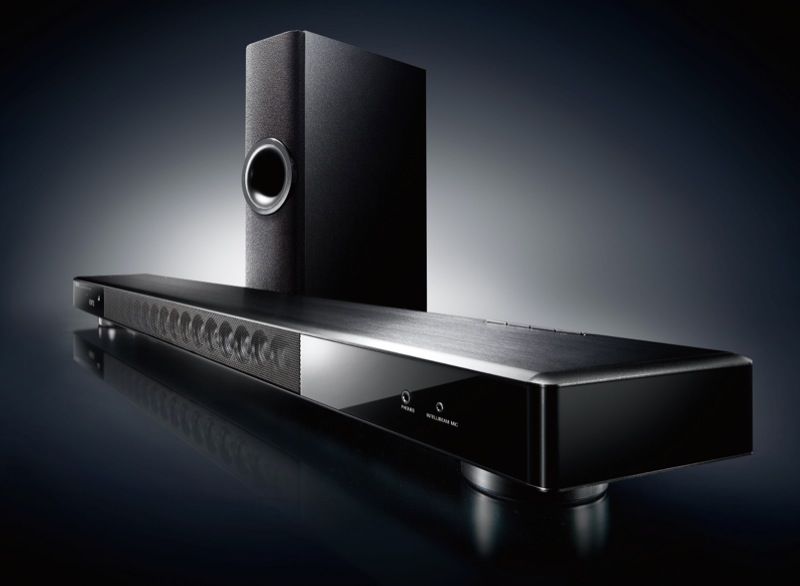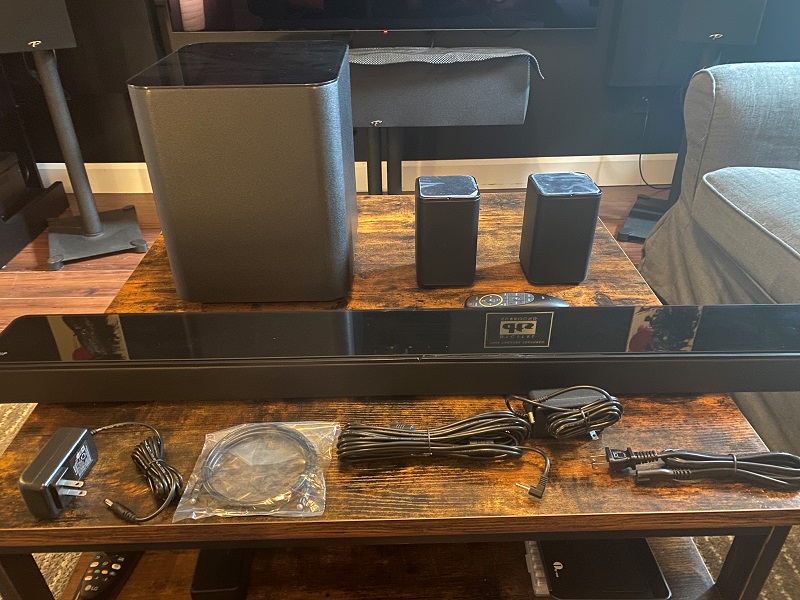Soundbars: All the Questions You Were Afraid to Ask
Our “Things You Always Wanted to Know” series takes on some of the most basic questions people have about our hobby. If you are a veteran of home theater and AV, you should know the answers to all of these questions. We all start somewhere and we get questions like these all the time. If you are new to home theater, or just want to test your knowledge, read on! These are all the questions you always wanted to know about soundbars but were afraid to ask!
What is a soundbar?
To begin with, we must define a soundbar. For the purposes of this article, a “soundbar” is a speaker that is designed to be placed near (usually below) a TV. It is a full speaker solution meaning it can be used by itself. Soundbars usually have more than one driver inside and may claim any number of channels. The key, is that they are a single speaker solution that can take the place of the speakers in your TV.

What is the difference between an active and a passive soundbar?
You may have seen soundbars that were listed as “active” or “passive.” The difference is how the speaker receives power. An active soundbar has amplifiers built into the speaker to power the drivers. The passive soundbar does not. With the active soundbar, you’ll need to plug it into a wall outlet so that the amplifiers can receive power. With the passive soundbar, you’ll need to run speaker wires from your AV receiver to your soundbar. The AV receiver will be providing the power. Active soundbars are much more common than passive. Not sure what you have? Look on the back. If it has a power cord, it is active. If it has speaker wire connections, it is passive.


What is the difference between a soundbar and a “surround bar”?
Soundbar and surround bar are often used interchangeably. If you wanted to be accurate, a soundbar will do no more than try to recreate stereo or three-channel sound (front left, right, and center sounds). Surround bars will, through DSP or additional speakers, attempt to recreate surround sound. Soundbars can be either active or passive. Surround bars almost always have to be active as they must decode the surround codec internally.
Why do some soundbars come with extra speakers?
Many soundbars will come with extra speakers. You can find some that arrive with a “subwoofer,” and others that will also have additional speakers. These speakers are designed to be placed around the listening area in order to create true surround sound. These additional speakers may be wired (directly to the soundbar usually) and may also require power (more on that next). If you want a more convincing surround sound effect, soundbars with additional speakers are the way to go.
Soundbars that claim surround capabilities without extra speakers are using DSP or Digital Signal Processing to change the sound. These bars will alter the phase, reverb, delay, and more of some of the sounds to “trick” your ears into thinking that there is sound coming from other directions than from the soundbar. These can sometimes be convincing, but sometimes not. It will be highly dependent on your room and you won’t know until you set them up and try it out.
How do those included “wireless” speakers work?
One question that people are not afraid to ask is about the wireless speakers that come with soundbars. Of course, each soundbar manufacturer has its own “wireless” solution so we’ll have to be general here. A “wireless” speaker is one where the information about what sounds to recreate is sent wirelessly. This means you won’t have to run a wire from the soundbar to all of those other speakers. That does not mean that the speakers are truly wireless.

In order for the speakers to make sound, they need power. This can come from a battery (which means you’d need to recharge your speakers). More commonly, it comes from a power cord. So, while the soundbars will be marketed as coming with “wireless” speakers, there is always still a wire. As surround speakers are often placed near a wall, and walls normally have outlets somewhere on them, this shouldn’t be too much of a problem.
Do I need a subwoofer?
Need is a strong word. We’d love to say yes, but we’d be lying. First, let’s talk about those “subwoofers” that are included with many soundbars. We keep putting the word subwoofer in quotes because the speakers that are included would be better labeled bass modules. These bass modules are designed to play some of the lower notes below what the soundbar can hit. It cannot recreate truly subsonic notes (down to 20Hz and below). And that’s fine. But they aren’t subwoofers, they are just bass modules. In almost every case, we’d suggest you buy just the soundbar and skip any bass modules. If you want to fill out the bottom end of the frequency response, buy a true subwoofer.

If you are buying a soundbar so that you can better hear the dialogue, you don’t need a subwoofer or a bass module. The soundbar can do all you need to better understand what people are saying. But if you are thinking you want more bass, a subwoofer can help you out. You’ll want to make sure that your soundbar has a subwoofer output. You’ll either have to connect a cable from the soundbar to the subwoofer or add some sort of wireless solution.
Can I place my soundbar above my TV?
The very easy answer is yes…but don’t tell the Internet. Placing a soundbar below a TV is traditional, but it works just as well above. Your brain will localize the sound as coming from the TV just fine. You may want to angle the speaker down towards your seat, especially if your TV is mounted very high on the wall. Otherwise, nearly any mount that would place a speaker under a TV will work with it above a TV. Double-check your instructions, but we’ve found this to be the case. The answer to this soundbar question is likely to send the audiophile police after us we’re afraid.
What kind of wires do I need?
It depends on the type of soundbar you have. Passive soundbars only require speaker wire. Active soundbars need to connect to a source (usually the TV). Different connection types have different abilities. Pick the best one for your situation (we have a guide to help you). Most soundbars come with all the cables you need. You’ll only need to purchase additional cables if the ones they included aren’t long enough.
How do I run wires to my soundbar? I don’t want to see them!
If your TV is wall-mounted, you can run your cables the same way. If you are doing this all for the first time, check out our wiring guide. Just remember that you cannot run the power cable through the wall. You’ll also want to double-check that the included cables are in-wall rated.
How many “channels” do I need?
When reading about a soundbar, you may notice that some claim a number of channels. Just like a surround sound speaker system, these channels indicate the number of positions that the soundbar can recreate. If they are claiming 3.1 channels, it means that there are three front channels and one subwoofer channel. If they are claiming 7.0 channels, it should be able to recreate seven floor-level speakers only (the zero indicates no dedicated subwoofer output).

But how can they do this from one bar? Usually with additional drivers and a whole bunch of DSP. If there is not a physical speaker included in the box, every one of the channels that are not coming directly from the soundbar (the front three), is simulated.
Is a Dolby Atmos soundbar better?
In a word, No. Dolby Atmos is an object-based audio format that is the new, shiny thing that everyone is excited about. Of course, soundbar manufacturers would want to slap an Atmos logo on their soundbars. Dolby Atmos provides for not only floor-level speakers but also overhead speakers. If you thought simulating surround sound was hard, try simulating overhead sounds!.
We’re not afraid to answer this question directly – soundbars advertising multiple channels are like cars advertising more than four wheels. Sure, you can make a case for it, but it is useless most of the time, and detrimental the rest. A soundbar should really do one thing – make it easier for people to hear what is happening on their TVs. Adding a bunch of simulated extra channels is just muddying everything up. Simple soundbars with only a few channels and maybe some wireless rear speakers is all you need. If you want more bass, get yourself a real subwoofer. You won’t regret it!
Wrap Up
We are going to call it here. There are a ton of questions about soundbars that people might be afraid to ask. If you have some, let us know and we’ll answer them in a follow-up article.


